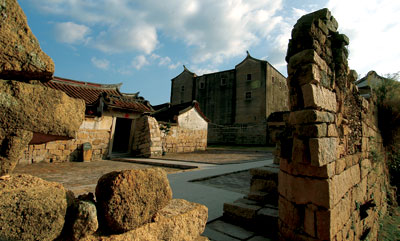 IN a rural area in Zhaopu County, Fujian Province, a 400-year-old ancient castle has been standing since the Ming Dynasty (1368-1644). It is said that the castle was a “mini kingdom” built by descendants of the Zhao family, the imperial family of the Song Dynasty (960-1279). People living near the castle maintain ancient customs and traditions. Discovering Zhao’s Castle Zhao’s Castle was discovered inadvertently in 1982 when Zhangzhou City, Fujian Province was applying for the title of “famous historical city.” During the application procedure, an unknown ancient town, which was known as Zhao’s Castle by the locals caught the examination team’s attention. Many experts were stunned at the sight of the castle since the moat and other essential facilities had been well preserved and its unique architectural style was rare in Fujian Province. After an investigation, the castle was confirmed to have been built at least as long ago as the late Ming Dynasty. Most of the locals were surnamed Zhao and claimed they were descendants of the ancient royal family, suggesting that it dates all the way back to the Song Dynasty. The original inhabitants in the area where the castle was located were from the She nationality, a nationality in which the surname Zhao does not otherwise exist. According to historical files and the local Zhao’s family book, these people were descendants of 他a brother of Zhao Kuangyin, the first emperor of the Song Dynasty. They hid themselves in the rural area of Fujian by changing their family name to Huang to avoid persecution when the Song Dynasty was overthrown by the Yuan army in 1291. The true identity of the family was exposed hundreds of years later after the Yuan Dynasty (1279-1368) was overthrown by the Ming Dynasty, and with the permission of Zhu Yuanzhang, the first emperor of the Ming Dynasty, they used their family name again and resumed the family traditions. A ‘Little Bianjing’ Although the Zhao family chose to settle down in Fujian Province which is in Southeast China, they have never forgotten where they came from — Bianjing, the Song Dynasty capital (today’s Kaifeng City, Henan Province). The castle was built to be very similar to the ancient Bianjing, and all the buildings in the surrounding area followed the ancient architectural styles of Bianjing. For example, there was a bridge in the castle, which had the same shape, style and name as a famous bridge in Bianjing of the Song Dynasty. The most famous building in Zhao’s Castle was called “Wanbi Tower.” It was also a military fortress for resisting invaders. Local people said the tower was built to resist Japanese invaders and had helped save their ancestors’ lives several times. Special ancient traditions After 700 years, residents near Zhao’s Castle maintain the customs and traditions passed down by their ancestors. At every Lantern Festival, the local people hold a grand banquet called “chidingzhuo.” Couples who get married and give birth this year will invite all the men aged 16 and over to the banquet. The banquet is to remind people of who they used to be and where they come from. “Xingshe” (Buddha parade) is another important custom at Zhao’s Castle. On every lunar Jan. 18, people take all the Buddha statues from temples and parade around the village. Statues of their ancestors, who were the 18 emperors of the Song Dynasty, were woshipped at the parade. Portraits of the emperors were the most sacred treasures of the Zhao family and were once exhibited in Zhangzhou, but they were lost during the Cultural Revolution. There is also an interesting event called “kaogui” (roast turtle). Every lunar January, sons of the Zhao family will participate in a shooting contest. The top three scorers can receive a turtle-shaped glutinous cake. The small one weighs about 5 kilograms, while the biggest one is about 10 to 15 kilograms. Those who can lift the cakes back home will be treated as heroes. “Turtle” has the same pronunciation as “going back” in Chinese, which shows the Zhao family’s wish of going back to their hometown. The wedding ceremony in the castle is also special. The bride and groom have to wear white clothes and pants and hold white stripes at the ceremony. The outfits will be kept carefully by the couples and be put on again at their parents’ funerals. After the couple die, the outfits are buried with them. It is said that the purpose of the outfit is to teach the Zhaos not to forget about their ancestors and always respect their parents. (Wang Yuanyuan) | 
